

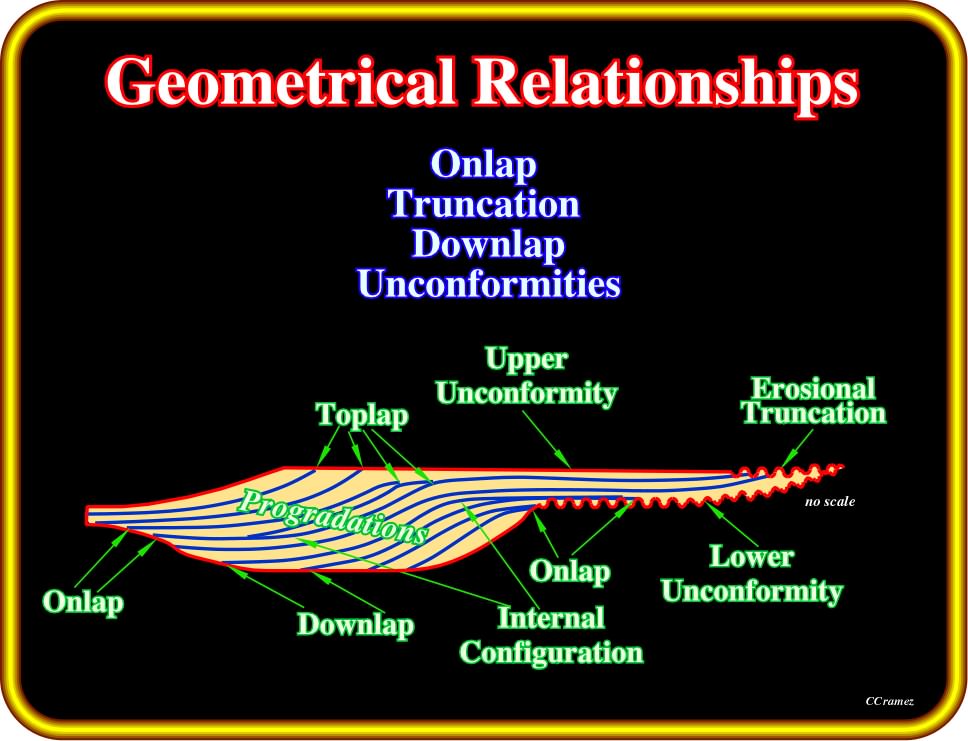
Plate 127- In the next pages, we will review the geometrical relationships (reflection terminations) associated with stratigraphic cycles and particularly with sequence cycles, i.e., stratigraphic cycles associated with 3rd order eustatic cycles, which are the building block of sequential stratigraphy. Each geometrical relationship (onlap, downlap, toplap, etc.) will be defined and illustrated on tentative interpretation of regional seismic line. We will try to explain its meaning in geological terms.
A base-discordant relation in which initially (deposition time) horizontal strata terminate progressively against an initially inclined surface, or in which initially inclined strata terminate progressively updip against a surface of greater initial inclination.
Varieties of onlap are:
(i) Proximal onlap ;
(ii) Distal onlap ;
(iii) Coastal onlap ;
(iv) Marine onlap ;
(v) Apparent onlap ;
(vi) Nonmarine onlap;
(vii) True onlap ;
(viii) Tilted onlap (apparent downlap).

Plate 128- The Annot sandstones are deep-water turbiditic lobes, which onlap a major unconformity (erosional surface induced by a significant relative sea level fall). As illustrated, one can say, the unconformity (in this case a marine erosional surface) is fossilized by the onlapping of turbidite depositional systems. As we will see later, in this particular example (turbiditic deposition), the onlap relations do not correspond to a relative sea level rise, but to the stacking of successive turbidite lobes induced by gravity currents, which generally (according P. Vail) are formed during lowstand geological situations (sea level below the shelf break).
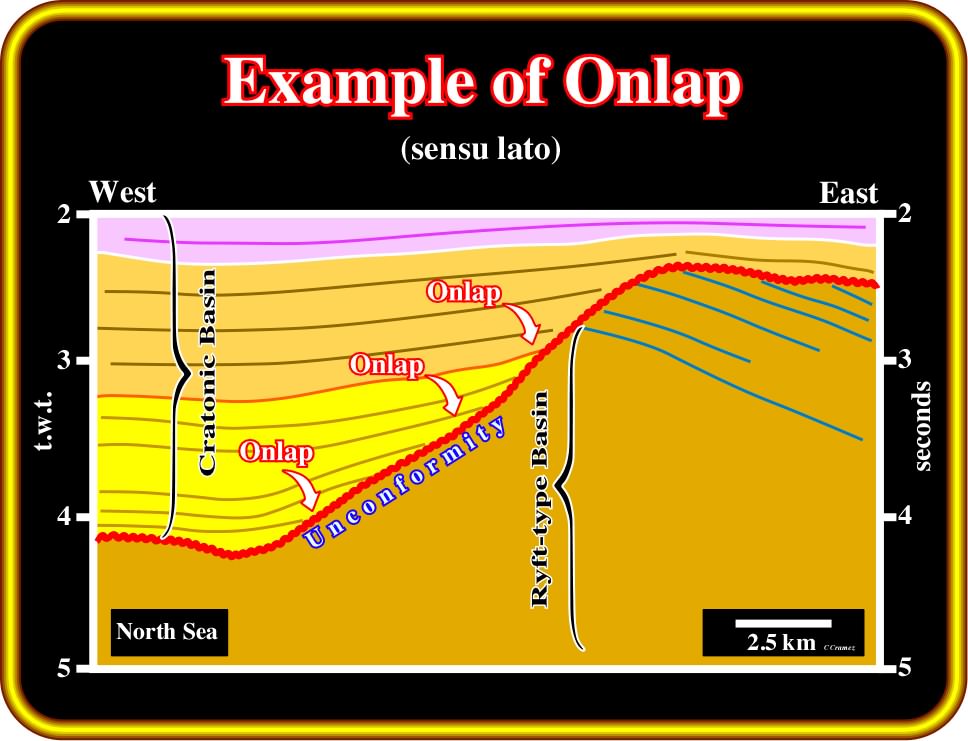
Plate 129- The North Sea is composed by three different sedimentary basins that are stacked together. From bottom to top geosciuentists, generally, have no major difficulties recognizing (i) a Paleozoic fold belt (not illustrated on this tentative interpretation), often considered as a petroleum basement ; (ii) a Mesozoic rift-type basins and (iii) a Cenozoic cratonic basin. On this geological tentative interpretation of a seismic line of North Sea, it is easy to recognize that cratonic Cenozoic sediments onlap Mesozoic rift-type basin sediments. Geoscientists and particularly seismic interpreters using the reflection terminations of the Cenozoic sediments, consider that an onlap seismic surface (not emphasized by seismic reflectors, but by reflection terminations) exists between the Mesozoic and Cenozoic intervals. Generally, onlap represents a marine (or lacustrine) transgression (or regression) over old sediments, that is to say, a relative sea level rise. In other words onlapping means aggradation, that is to say, build up to a level by depositing sediments. Different types of onlap can be recognized either on the ground or on the seismic lines.
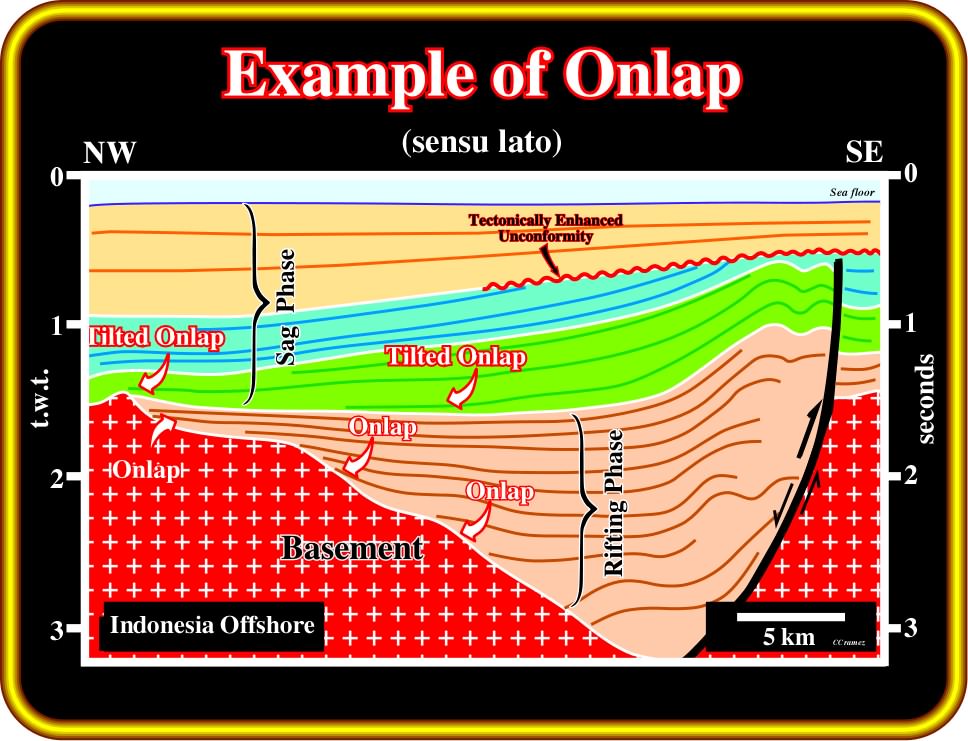
Plate 130- The pristine geometrical relationships (deposition time) are often deformed by later tectonic regimes, as illustrated on this tentative interpretation of seismic line of a SE Asia back-arc basin. In fact, it is quite easy to infer that a compressional tectonic regime took place after the rifting phase of the backarc basin. The old normal fault (in black) bordering the rift-type (rifting phase of the back-arc basin) was reactivated as reverse fault tilting (uplifting) the original geometrical relationships between the seismic markers. When the tilting is strong enough, onlapping can apparently become another geometrical relationship, as it is the case in the green seismic interval (apparent downlap). Note in the upper part of the interpretation ( sag phase of the back-arc basin) a local tectonically enhanced unconformity (angular unconformity for certain geoscientists). In this particular case, it is quite easy to recognize that such an unconformity is just an eustatic unconformity (mainly induced by a eustatic relative sea level fall) locally enhanced by the tectonics.
(i) Proximal Onlap
A proximal onlap is an onlap in the direction of the source of clastic supply (generally looking landward).
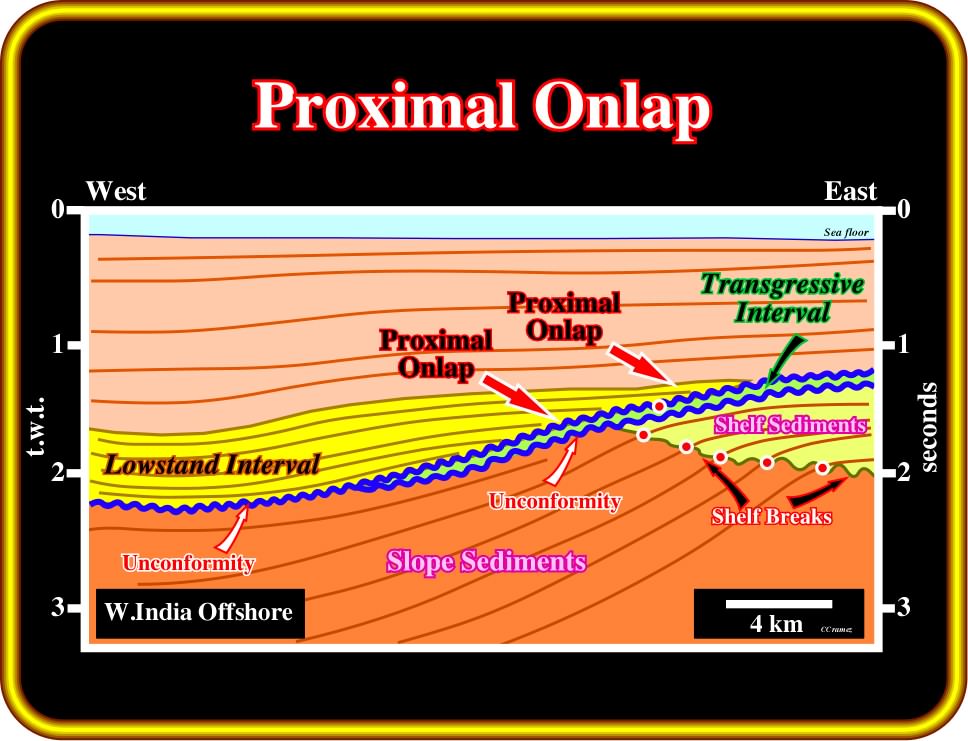
Plate 131 - In this tentative interpretation of an offshore West India seismic line, the source of clastic supply is located eastward. The red arrows underlie proximal onlaps, which can be coastal or marine, depending whether they are associated with marine sediments (seaward of the shelf break) or shallow marine (lanfward of depositional coastal break). On this tentative interpretation (Atlantic-type divergent margin), the onlaps are coastal. They are associated with the aggradation of a lowstand regressive interval (lowstand prograding wedge, LPW), which fossilize an unconformity (seismic onlap surface) induced by a relative sea level fall, which took place between the transgressive interval (green, between two unconformities) and the regressive lowstand interval (in yellow). Note the evolution of the shelf break, i.e., the progradation of the shelf break during the lowermost regressive interval.
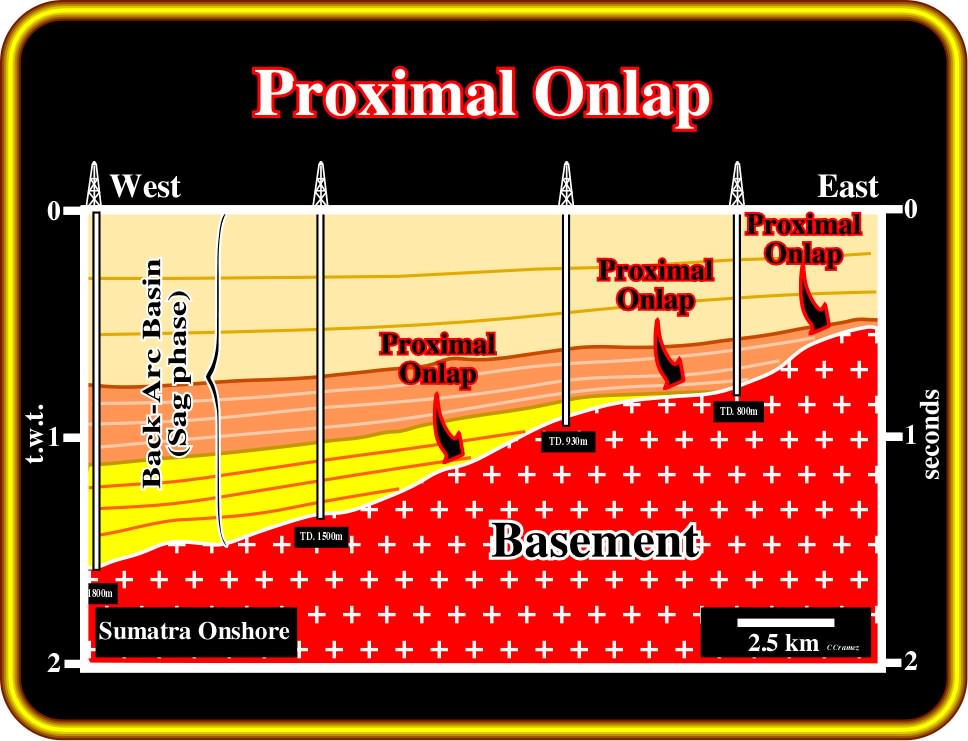
Plate 132 - On this tentative interpretation of a seismic line from onshore Sumatra (Cenozoic back-arc basin induced by a Benioff or B-type subduction zone), the proximal onlaps of the seismic reflectors (upper seismic packages of the sag phase of the back-arc basin) are easily recognized. Actually, taking into account the proposed geological interpretation, it is quite evident that the more likely source of clastic sediments is the basement, which outcrops few kilometers eastward. Theoretically, the onlap seismic surface, between the sag sediment terminations and the basement (granito-gneiss or Paleozoic fold belt), is created by the coastal aggradation of the regressive intervals of the back-arc basin. Deep-water turbidite depositional systems were deposited during relative sea level falls (unconformities) bounding the different intervals, generally, in lowstand geological situation (sea level below the shelf break).
(ii) Distal Onlap
A distal onlap is an onlap in the direction away from the source of clastic supply (generally looking seaward).
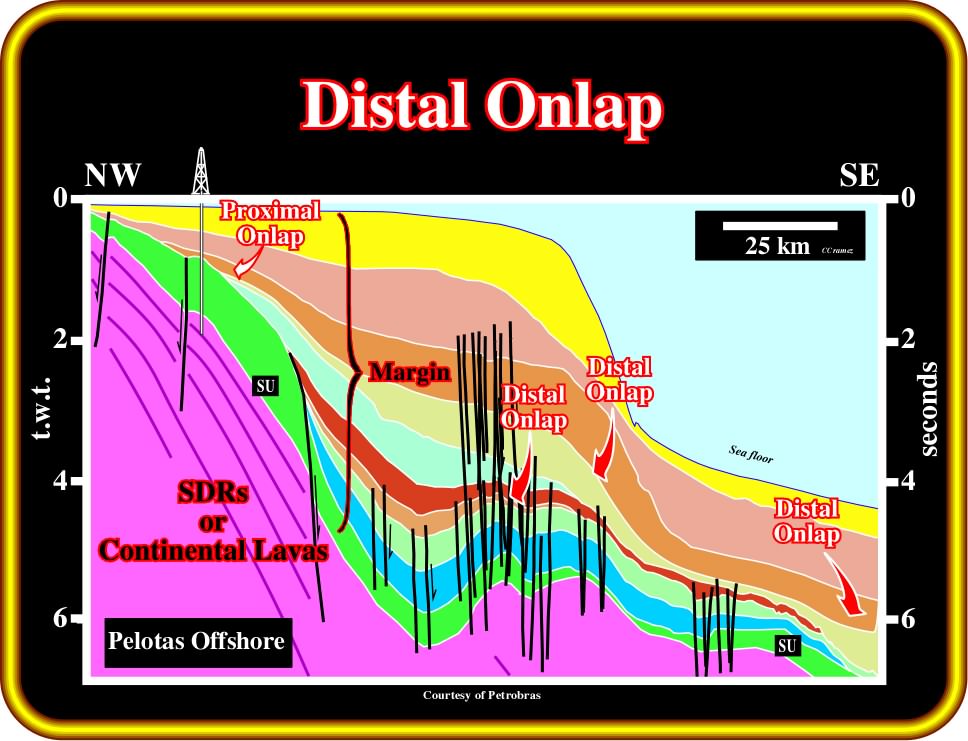
Plate 133 - Distal onlaps are easily recognized on regional seismic lines of the Brazil offshore (post-Pangea Atlantic-type divergent margin). In this margin, as depicted on this tentative interpretation of a regional seismic line of Pelotas basin, the petroleum basement is mainly composed by Mesozoic subaerial lava flows, which locally can overly Precambrian and Paleozoic sediments. The most likely source of clastic sediments are the rocks of the infrastructure (Precambrian or Paleozoic rocks) and the post breakup lava flows. Both outcrop westward and were corroborated by drilling. Subsequently, distal onlaps of the Atlantic-type margin, as stressed above, are the reflection terminations in the direction away of the source of clastic supply (southeastward terminations). The unconformity (SU), on the top of the lava flows (seaward dipping reflectors), is not the breakup unconformity. In fact, it is more or less 10 My younger than the breakup unconformity (BUU), which is not visible on this tentative interpretation. Take into account the pitfall induced by the sharp change in water depth. All reflectors below the present shelf break (slope and abyssal plain) are strongly pull-down. In other words, in a depth version of the line, the majority of this reflector dips landward, which enhances the distal position of the onlapping.
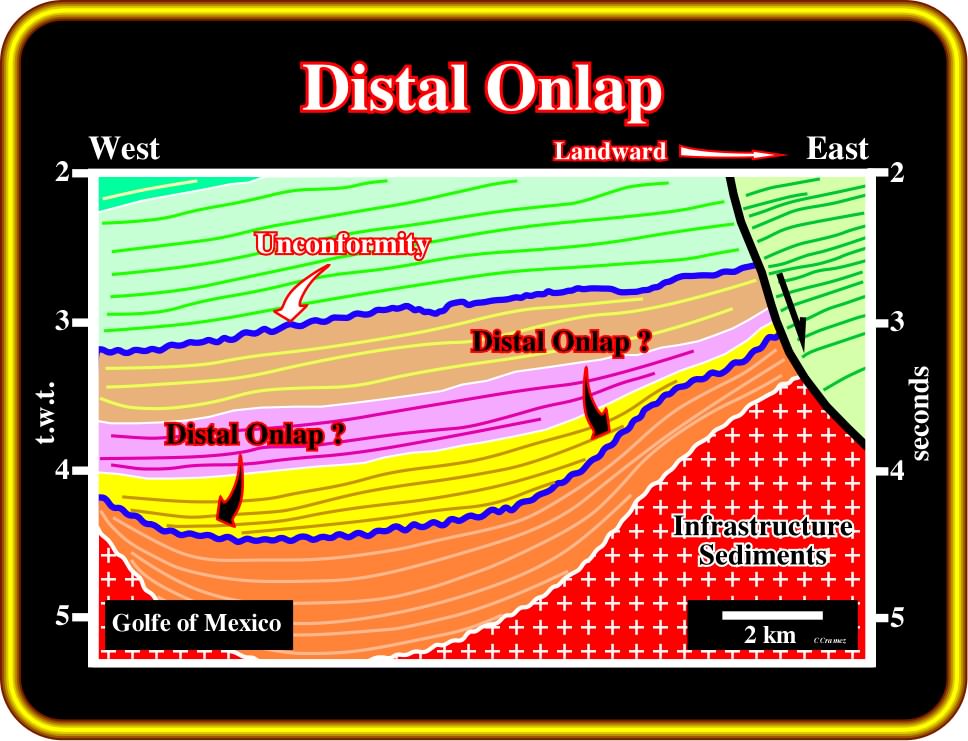
Plate 134 - On this tentative interpretation of a seismic line of the deep-water Gulf of Mexico (Cenozoic Mediterranean-type basin overlying a Mesozoic Pannonian basin), reflection terminations and seismic surfaces are quite easy to recognize. However, in spite of the fact that the source of clastic sediments is located eastward (landward), is quite difficult to differentiate proximal from distal onlap. In fact, due to salt flowage (halokinesis) and particularly due to the salt evacuation, salt expulsion basins (minibasins for certain American geoscientists) control the gravity currents, which can take fancy trajectories. Subsequently, in a salt minibasin, a distal onlap does not necessarily mean that the onlap is in the direction (same sense) of the major source of clastic supply. In other words, in deep-water minibasin environments, the direction of the source of clastic supply does not necessary corresponds to the regional direction of the sediment transportation. In this tentative interpretation, the interval named infrastructure sediments comprise the salt layer and infrasalt sediments, that is to say, all sediments below the overburden (strata younger than the salt substratum or source layer).
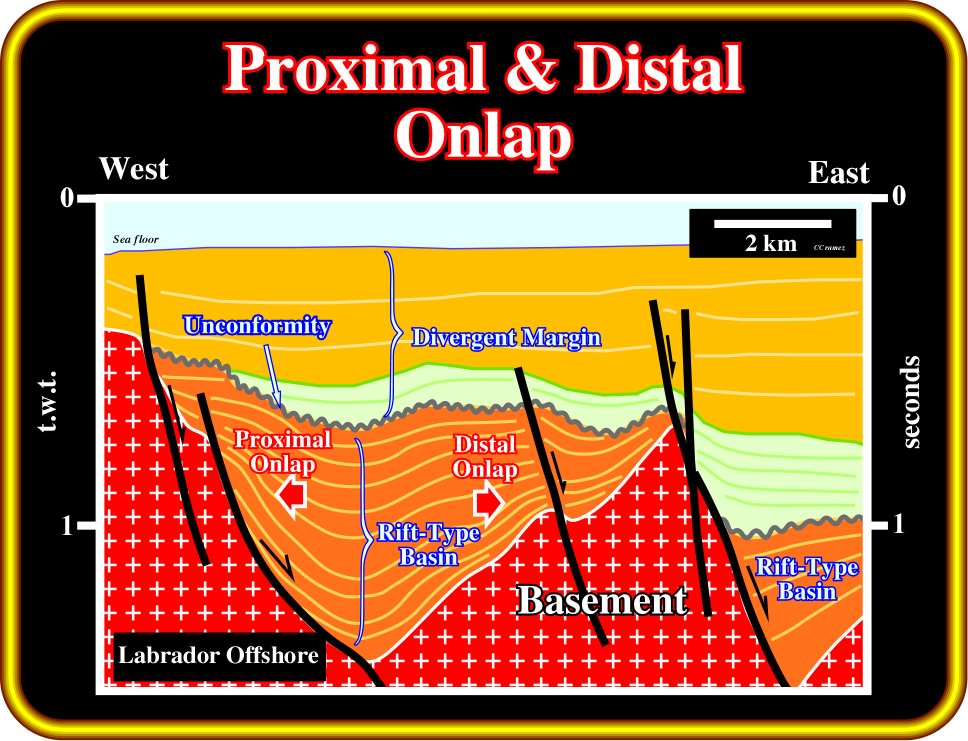
Plate 135 - On this tentative interpretation of a seismic line of the Labrador offshore, the geometry of the rift-type basin, as show in, is often that of a half-graben. The infilling sediments thick landward toward the normal fault planes (the subsidence is differential). Such a feature, strongly suggests that the direction of the source of clastic supply is from west to east. Subsequently, proximal onlaps look westward (landward), while distal onlaps look eastward (seaward). However, it must be noted that the onlaps are non-marine. The predominant geological environment in rift-type basins is alluvial or fluvial, in which parent materials are deposited by moving water bodies such as rivers and streams. In addition, under certain climate and geological conditions, lacustrine environments can develop and organic rich lacustrine shale can be deposited forming potential source-rock (organic matter type I).
(iii) Coastal Onlap
A coastal onlap is the progressive landward onlap of the coastal deposits in a given stratigraphic unit.
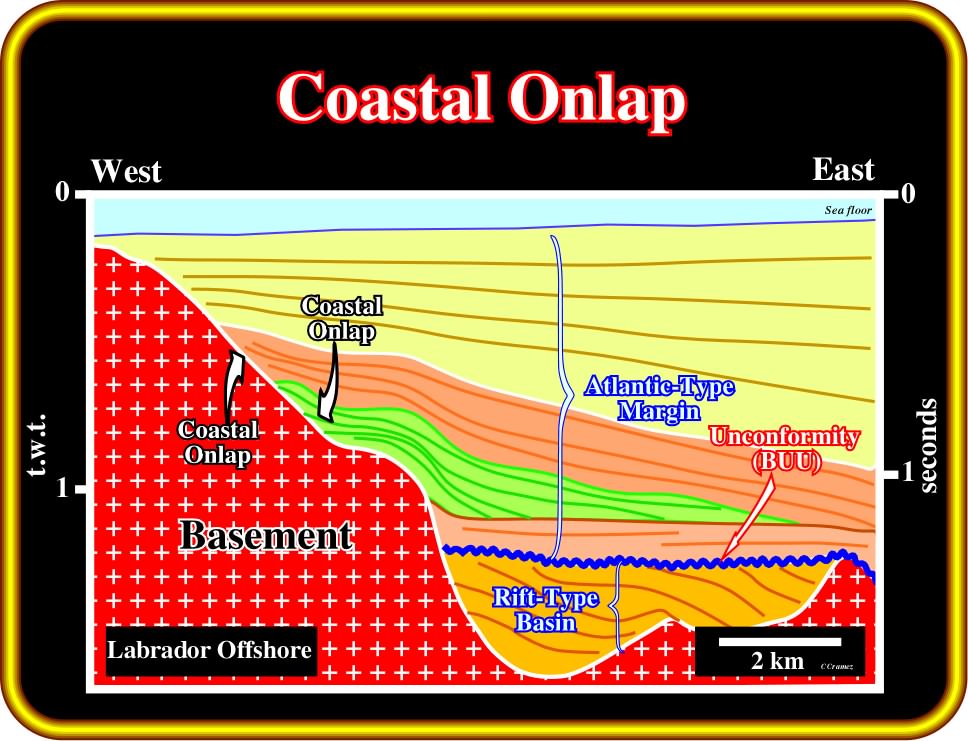
Plate 136 - The offshore of Labrador corresponds to a Cenozoic Atlantic-type divergent margin, which overlies Mesozoic rift-type basins, i.e., half-grabens which have lengthened the lithosphere during the rifting phase (before breakup and subsequently oceanization). On this tentative interpretation of a regional line of this area, the green interval represents a transgressive sedimentary package of the margin developed during a relative sea level rise. In this interval, the coastal onlaps are quite evident. The coastal aggradation (vertical component of coastal onlap) of this transgressive interval is around 400 milliseconds (t.w.t.) and the coastal encroachment (horizontal component of the coastal onlap) is roughly 4000 meters. For a given stratigraphic unit, the knowledge of the coastal aggradation and coastal encroachment allows prediction of the most likely topography of the underlying unconformity on which the unit transgressed. The breakup unconformity (BUU) between the rift-type basins and margin marks to a sharp change in environmental conditions. Above the BUU the environment is mainly marine, while below, it is mainly non-marine (lacustrine when the internal configuration is more or less parallel).
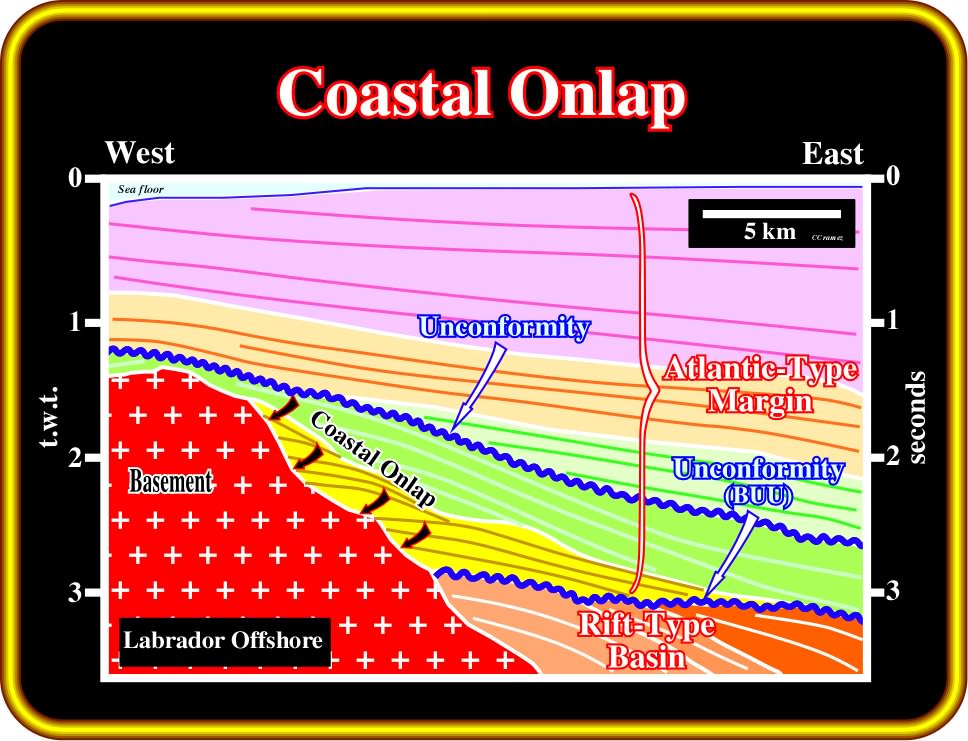
Plate 137 - This tentative interpretation of a seismic line, located not very far from the line interpreted on the previous plate (Plate 136), illustrates coastal onlaps in a transgressive interval (yellow), which are easily recognized by the backstepping geometry. At each relative sea level rise, the depositional coastal break is displaced landward. Then, during a more or less stillstand of sea level, the depositional coastal break is progressively displaced seaward as sedimentation takes place. However, it never reaches the position of the last depositional coastal break of the previous parasequence (see later). A new relative sea level rise, again, displaces the depositional coastal break landward, and so on. This depositional mechanism is responsible of the backstepping geometry of the transgressive deposits, which, in fact correspond to a set of less and less regressive deposits. In other words, in a transgressive interval, each paracycle sequence or parasequence (without relative sea level fall between them) has a progradational (forestepping) or regressive geometry as indicated by internal configuration, which quite often is under the seismic resolution, as it is the case here. However, a typical progradation internal configuration is always visible in the cored intervals.
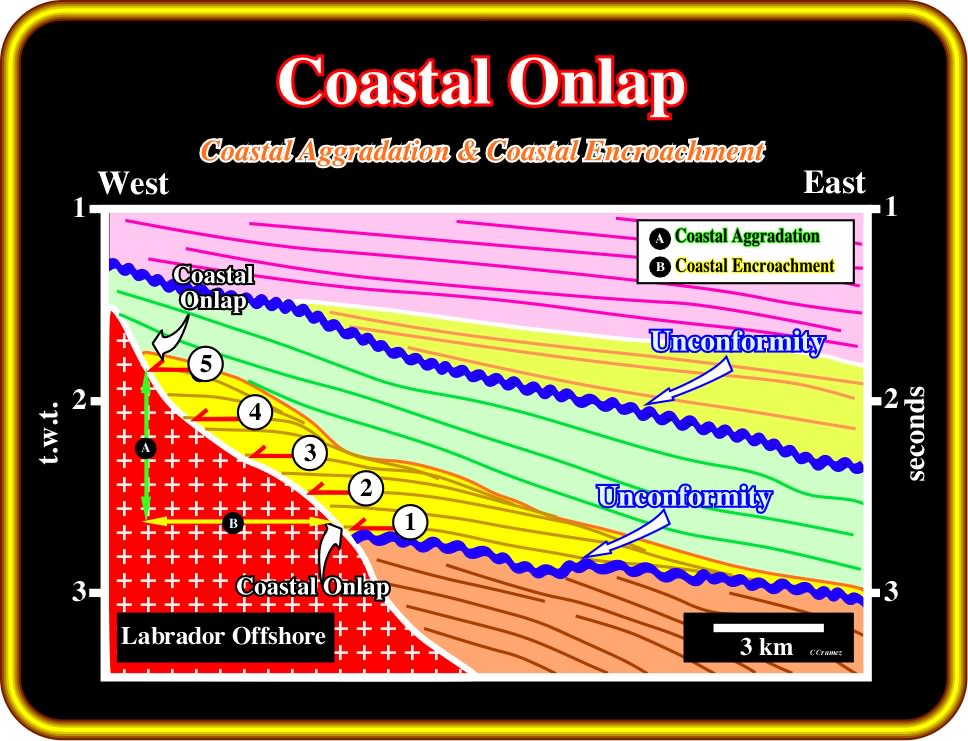
Plate 138 - This tentative interpretation of a seismic line of Labrador offshore depicts a coastal aggradation (A), i.e., the vertical component of the coastal onlap of a regressive interval (green) and coastal encroachment (B), that is to say, the horizontal component. Coastal encroachment is measured in kilometers, while the coastal aggradation is measured in milliseconds (two way time). A quickly time/depth conversion of the coastal aggradation, as we will see later, gives the total relative sea level rise. Knowing the coastal aggradation (in meters or kilometers) and coastal encroachment, it is possible to get an idea of the morphology of the basement over which the sediments transgressed. A high coastal encroachment coupled with a low aggradation characterizes a flat morphology of the underlying unconformity (eventually basement), while a relative high aggradation and a small encroachment characterizes a steep morphology. In the last case, the backstepping geometry of the transgressive interval is quite sharp, since it s thickness increase landward developing condensed stratigraphic sections in the distal part of the shelf (starved conditions).
(iv) Marine Onlap
Marine onlap is the onlap of marine strata, primarily deep marine (deposited seaward of the shelf break) in nature.
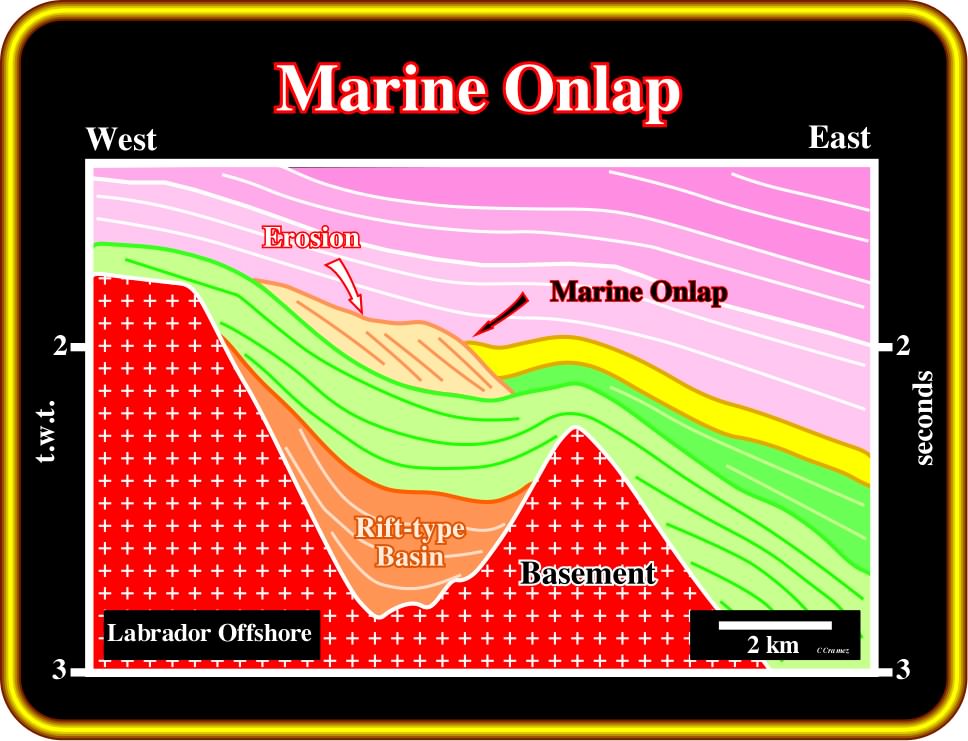
Plate 139 - On this tentative interpretation, certain geoscientists have considered the onlap of the yellow interval as a marine onlap. Others think that it is rather a coastal onlap than a marine onlap. In fact, in the central part of the line, it is easy to recognize a lowstand regressive interval, bounded above by an erosional surface. The upper parts of the progradations, forming the regressive interval, were partially eroded. So, at the time of erosion, that is to say, at the end of the regressive interval, the basin did not have a shelf. The depositional costal break (more or less the shoreline) was coincident with the shelf break. Subsequently, following a small relative sea level fall, the coastal deposits were slightly shifted seaward and basinward, and so, the onlap of the yellow interval must be considered as a coastal onlap. Marine onlaps, as show in next plate, occur when the basin has a shelf (coastal break and shelf break not coincident) or when the relative sea level fall is big enough to create a change of environment of the depositional systems.
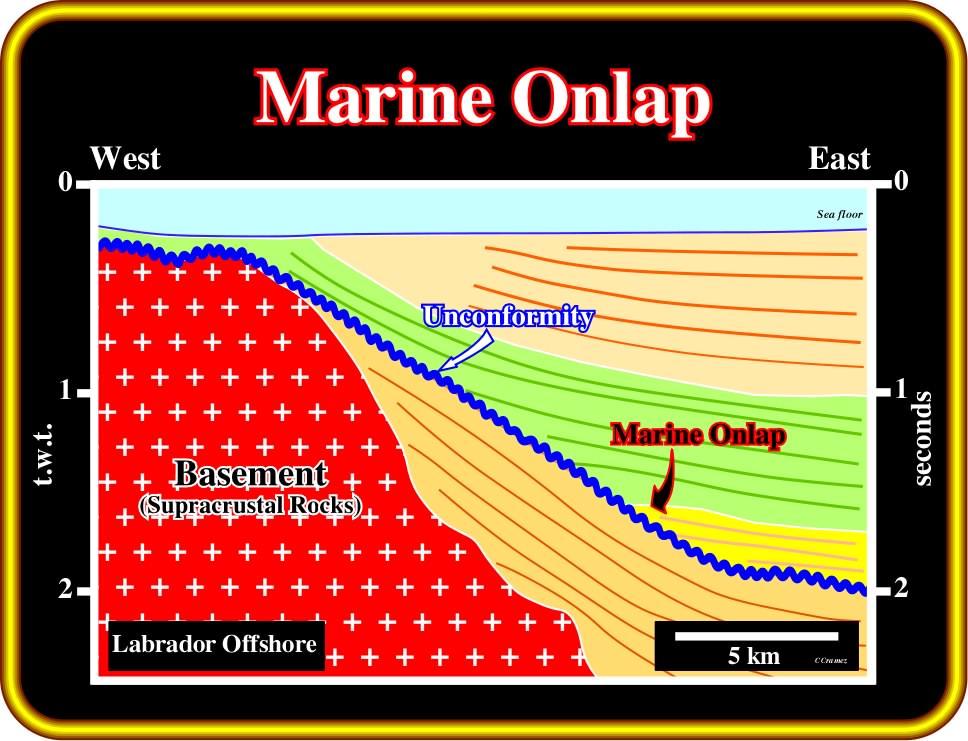
Plate 140 - On this tentative interpretation of a regional line of the Labrador offshore (parallel to the direction of the source of clastic supply), the turbidite depositional systems of a basin floor fan interval (yellow package) onlaps (marine onlap) on a major unconformity (in blue), which seems to have been induced by an eastward tilting of the basin. As with coastal deposits one could speak of marine aggradation and marine encroachment. However, traditionally, geoscientists keep aggradation and encroachment to express the vertical and horizontal components of coastal onlap. Marine onlap implies a significant depositional water depth. In coastal onlap, the water depth is practically zero. In spite of the fact the basement is mainly composed by Precambrian supracrustal rocks, the majority of the reflectors visible in the basement (not indicated in this tentative) are seismic artifacts, mainly peg-legs. It is interesting to notice that the uppermost reflectors are truncated, which means that the sea floor corresponds to an erosional surface., which geoscientists explain as a consequence of the isostatic rebound following the recent deglaciation (The uncovering of glaciated land because of melting or sublimation of the glacier). On the other hand, the local landward increasing of the water depth is explained by the scouring the icebergs in their trajectory toward warm waters.
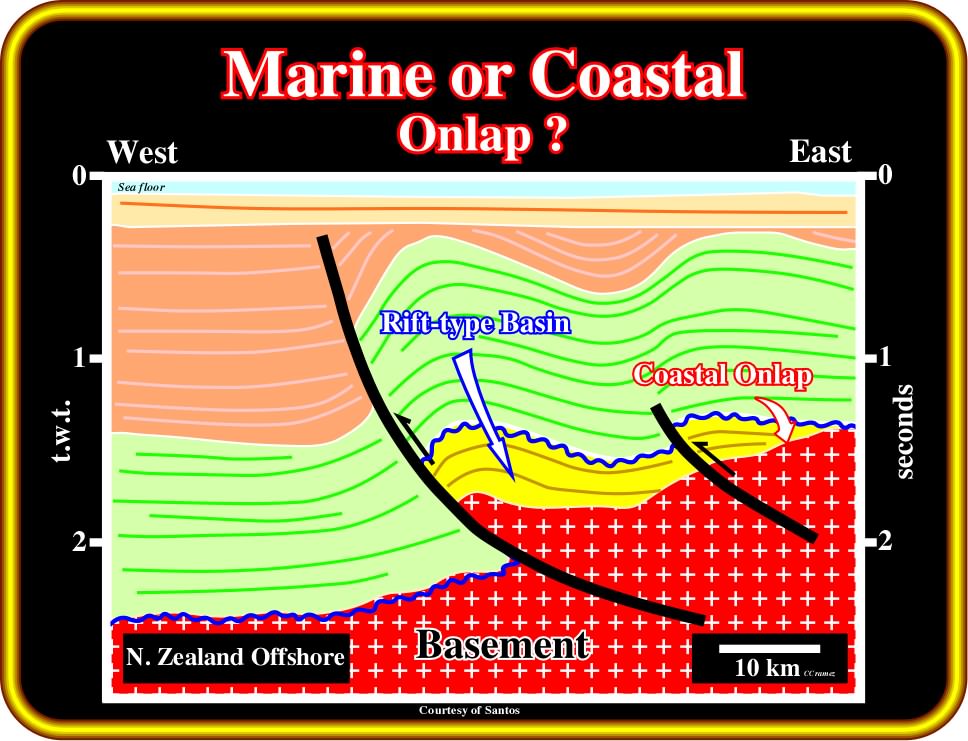
Plate 141 - On this tentative interpretation of a regional line of the offshore New Zealand, compressional structures are paramount. These structures seem to have been developed by a significant tectonic inversion. In fact, it is quite possible that the old normal faults, developed during the rifting phase (extensional phase), were later, during a compressional tectonic regime, reactivated as reverse faults. If such a tectonic interpretation is not refuted by additional data, the onlap recognized on the yellow seismic interval is coastal (or nonmarine) rather than marine. Actually, in this tectonic interpretation, the yellow interval is interpreted as the infilling of a rift-type basin, which are generally infilled by non marine sediments. However, it is evident that the seismic line can be interpreted in a differently way , as illustrated on the next plate.
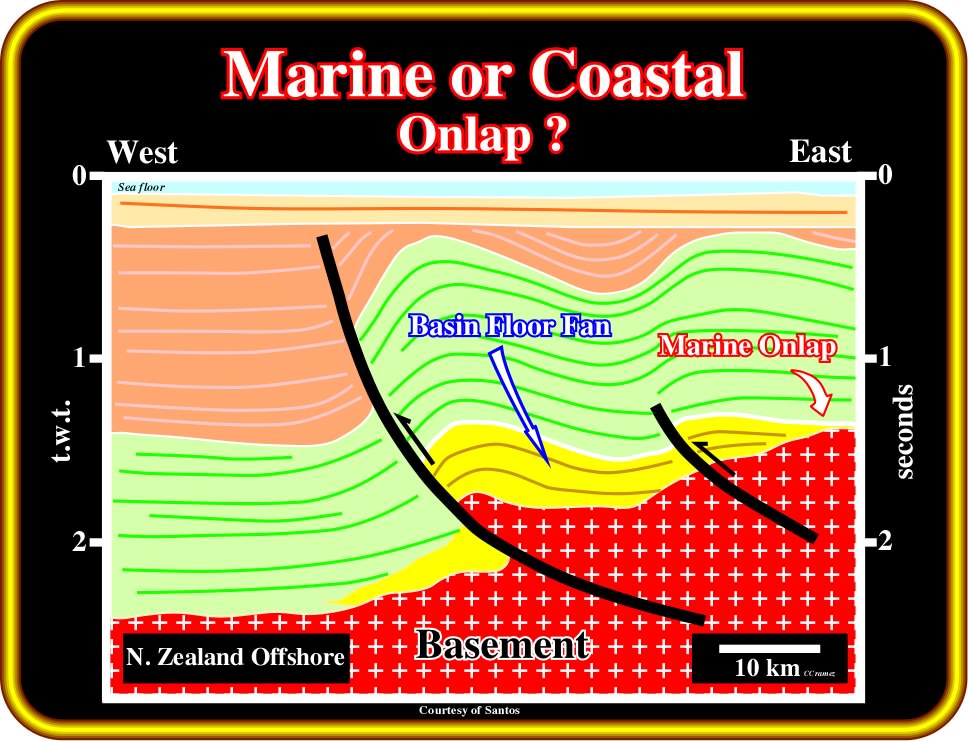
Plate 142 - In an alternative interpretation of the previous line, the yellow interval is interpreted not as a rift-type basin, but as a marine interval, likely a deep-water turbidite package deposited over a basement. If such a hypothesis is not refuted, the geometrical relationships between the yellow strata and the basement must be interpreted as marine onlap. This example clearly indicates that seismic interpretation cannot be done in isolation. It is strongly dependent of the regional and global geological settings and the geological knowledge of the interpreter. On the other hand, geoscientists and particularly seismic interpreters, should never forget that there are no true interpretations. All tentative seismic interpretations will be, sooner or later, refuted by new geological data. Strictly speaking, a seismic interpretation can never be verified. It can only be validated or corroborated. geoscientists progress by trial and errors, which means that seismic data must be interpreted several times using different priori hypothesis (observation is dependent of the theory assumed by the observer).
Send E-mail to carloscramez@gmail.com with questions or comments about these notes (Seismic-Sequential Stratigraphy).
Copyright © 2003 CCramez
Last modification: September, 2014